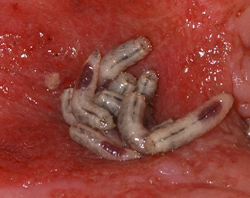Maggots
The larvae of some species of true fly (insects in the Order Diptera) are commonly called maggots.
Maggots have a conical body form (i.e. extending to a point). The anterior or head-end is pointed with the posterior end being more blunt. The posterior end of the maggot often has two dark areas that can be mistaken for eyes. These are actually the spiracles (breathing holes) for the maggot and enable the maggot to breathe whilst burrowing down into whatever it is feeding on.
At the anterior end are the maggot's mouthparts and these are often hook-like. In many species the structure of the mouthparts is the best way to identify the species of fly from its maggot.
Many species of fly have maggots that feed on carrion. Forensic entomologists can collect and identify maggots from human corpses. The presence of different species of fly larvae can tell investigators much about the time of death or if the body has been moved.

A photograph of blowfly maggots.
Photograph by United States Department of Health and Human Services.
Related terms
Related groups of terms
Related pages on this web site
Back to Glossary
If you have found this glossary useful please consider supporting the Amateur Entomologists' Society by becoming a member or making a donation.
![Amateur Entomologists' Society home page [Logo]](/images/aes-logo-wplant.gif)